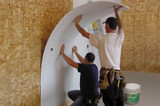Kennel Materials - HDPE vs FRP

FRP (Fiber Reinforced Plastic) and HDPE (High Density Polyethylene) are common materials used to "dog-proof" walls of a kennel facility. Both materials work great - but which one should you use?
It really depends on HOW you plan on using the materials.
First, let's get some understanding about the similarities and differences between the two:

FRP (Fiber Reinforced Plastic)
FRP is a thin sheet of plastic or resin that has fibers such as fiberglass, carbon, aramid or basalt added to strengthen it. Originally developed as an alternative to wood paneling - the waterproof nature of the material has led to its use in multiple applications! You have seen this material before - as it is commonly used in bathrooms to line shower-stalls.
Some benefits of FRP in the kennel facility:
- High strength to weight ratio.
- Waterproof.
- Low Warping.
- Dimensional Stability.
- Can be glued to existing walls to 'dog-proof them.
- Relatively inexpensive.
Some Downsides to FRP in the kennel facility:
- Thin sheet must be fully supported.
- Usually only has 1 side intended to be exposed.
- Limited color options.
- Can become brittle in cold weather.
- Scratches can cut through the protective finish and expose the fibers inside.
- If manufactured without a UV protective cap, it can degrade in the sun.
Some places where FRP can be used in the kennel facility:
- As a 'dog-proof' wall protector. Protects sheetrock, wood, and metal.
- As an anti fence-fight panel between kennels.
- As a floor protector in a whelping-pen

HDPE (High Density PolyEthylene)
HDPE is a sheet of solid plastic that comes in a variety of thicknesses. You can get thin sheets and use them in the same way you might use FRP - or you can use thicker sheets for more durability. Being solid plastic, the sheets will not be compromised by scratches or become as brittle in the cold. You have seen HDPE as it is commonly used as the dividers in public restrooms and on outdoor playgrounds.
Some benefits of HDPE in the kennel facility:
- Waterproof.
- Moderate amount of color options.
- Thicker sheets can be used in areas that need more structural support.
Some Downsides to HDPE in the kennel facility:
- Moderate warping in the sun or in cold.
- Moderate amount of color options.
- Hard to glue to existing walls since glues typically do not stick.
- If manufactured without a UV protective cap, it can degrade in the sun.
Some places where HDPE can be used in the kennel facility:
- As a 'dog-proof' wall protector. Protects sheetrock, wood, and metal.
- As an anti fence-fight panel between kennels.
- As a floor protector in a whelping-pen
As you can see, both materials can be used in the same places and for the same reasons... So which material should you use? Well, there are a couple more things to consider:
Questions to help you determine FRP vs HDPE in your application:
Which material is easier to obtain in my area?
Most home-improvement stores sell FRP for use in showers, so it is relatively easy to get. The colors may be limited as those stores typically do not have a lot of space to dedicate towards different colors.
HDPE can be found at many farm and ranch stores - however, they typically have only 1 color available: 'Natural' - which is a milk-carton white color. This is because the 'natural' color does not have any dyes and is the cheapest color to get. There are, however, a number of plastic distributors scattered across the country that can get you HDPE in a multitude of colors! Sometimes they might not have the specific color you are looking for in-stock, but they might have it at a different location - or can source it directly from the manufacturer. Many plastic distributors will also deliver - which is good because HDPE can get very heavy - especially if you are after the thicker sheets!
Will I be attaching to an existing structure?
This question has multiple parts... If you plan on using the material to line your walls - both FRP and HDPE make great candidates. However, if your walls are not finished yet (you just have studs) - you can use a thicker HDPE sheet (say ½" thick) and skip the plywood or drywall altogether. This might make the HDPE application slightly cheaper (since you do not have to buy plywood or drywall). On the flip-side, if you already have finished walls, you can use FRP as it will be easier to glue directly to the wall and will be cheaper than HDPE.
If you plan on using the material to attach to existing wire kennels, then I would suggest HDPE - hands down. Yes - I have seen some people use FRP - however, FRP has only 1 side that is intended to be exposed to water or UV - meaning the other side will degrade. (Usually, you can tell the difference between the two sides because the finished side is shiny - it might also have a texture). Also, since FRP is thinner, it tends to flex when dogs jump against it easier and dogs nails can puncture holes in it. HDPE can also bend slightly, so here is another time I might suggest a slightly thicker sheet (like ¼" thick). Unlike FRP, HDPE is meant to be exposed on both sides, so it does not matter if the sun or water hits both sides of it.
Which material will be easier to attach?
This questions goes with the one above. If you are planning on attaching either FRP or HDPE to your existing walls, you need to consider the limitations to the materials. FRP can easily be glued to sheetrock or plywood - making it a very easy material to install on top of finished walls. HDPE on the other hand cannot be easily glued, so it must be screwed in place. Some people have had success with epoxy-based liquid-nails to adhere HDPE - but I have not.

I have seen people use zip-ties to attach to wire mesh kennels for both FRP and HDPE - but HDPE tends to last a little longer without the holes 'tearing-out'. Another option might be to use long bolts with large washers and simply 'sandwich' the FRP or HDPE between the wire mesh and the washers.
Which Colors do you want?
FRP can be found in most home-improvement stores - making it easy to find... however, you might be disappointed to learn the limited color options you have available. For example, in my area only white and beige can be found in-stock. There are a few places that can bring other colors in (with minimum orders, lead-times, etc). FRP can be painted - just keep in mind that dogs will scratch the paint off over time. Some kennel manufacturers do have FRP panels for sale. They also have a lot more available colors than most home-improvement stores... of course, they are going to try to sell you completed kennels when you talk to them, so it can be hard to get the raw FRP sheets for your other needs.
HDPE can be harder to find up-front... but if you do have a plastic distributor near you, you might have a lot more potential color options available. Most big cities have a distributor close by (and many will even deliver up to 60-70 miles away). Sometimes minimum quantities, lead-times, and extra shipping costs might be required to get the color you want. HDPE cannot really be painted. Most paints will not stick well. In fact, one of the reasons that HDPE is used in outdoor playgrounds is because graffiti can be washed off!

Dog Kennels with HDPE side panels.
In Conclusion:
As you can see, it is not as cut and dry as some make it out to be. BOTH materials can work great - depending on some very specific details. Every kennel situation is slightly different and every location has different available sources. Hopefully, I've shown you the questions that you can answer for your specific situation so that you can determine which material will be best for you.
We use HDPE in our kennels because we like the structural strength it provides. We also use both sides of the material, so the single-sided FRP will not work in our application.
This is part of a series of blog posts about starting your own dog daycare or boarding business. Click here for the entire series.

